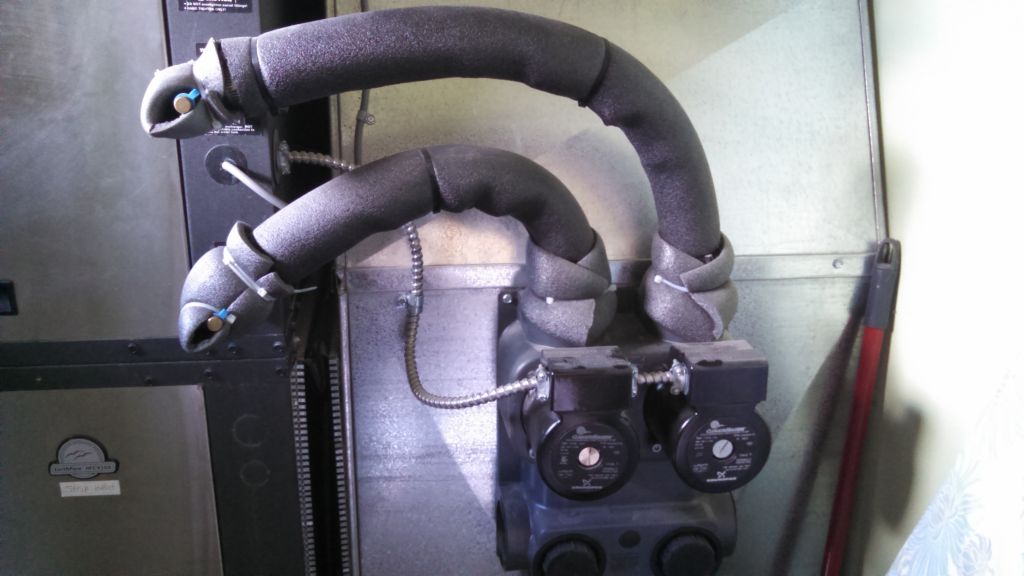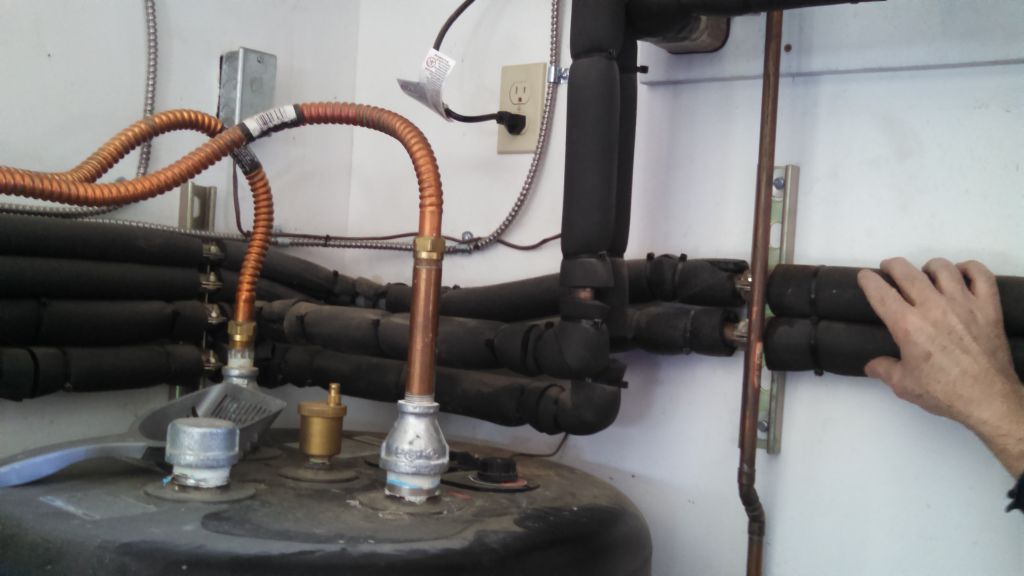
 |
|
|
#11 |
|
Helper EcoRenovator
Join Date: May 2011
Location: Western Washington
Posts: 91
Thanks: 47
Thanked 20 Times in 13 Posts
|
The system is completed and running! It has been for a few months now, but life gets in the way. I will take some pics of the hardware, get links for the solar panels, and try to explain that system. It is complicated.
There are loops in the floor of the garage. The solar heat can: 1) heat up about 80 gallons of hot water upstream of the 52 gallon (required) electric tank. 2) Heat the garage floor. 3) Push solar heat into the ground loops. There is a waste heat recovery loop in the heat pump that heats the water in the 52 gallon domestic tank. This spring the house was in construction mode, heated to about 55 for drying paint and drywall, keeping the moisture out, etc. The waste heat recovery loop kept the 52 gallons at about 100 degrees F. The electric elements have not been turned on. He will have a huge surplus of hot water when they are in the home full time. |
|
|

|
|
|
#12 |
|
Journeyman EcoRenovator
Join Date: Jan 2011
Location: Seattle
Posts: 326
Thanks: 109
Thanked 23 Times in 18 Posts
|
Now we need some pics.......
|
|
|

|
|
|
#13 |
|
Helper EcoRenovator
Join Date: May 2011
Location: Western Washington
Posts: 91
Thanks: 47
Thanked 20 Times in 13 Posts
|
Copied from the other thread:
Quote: Originally Posted by skyking View Post 98904 central Washington of much solar. he *just* had a 9900 watt solar system installed last week Heat load analysis? The heating company may have but I don't know the results. 3x600 by 3/4 onto a 1 1/4 header. Sounds like your brothers system is just barely pulling the grade. It would be a good idea to do a heat load analysis (AKA: heat loss analysis), so that you have some idea where the heat is going. GSHP and solar heating are considered 'renewable heating' which is another way of saying 'low temperature heating'. You can't treat it like fossil fuel heat. My bet is that you need to reduce the heat losses. Infiltration is where it starts, as most heat loss is due to infiltration. A blower door test will tell you how bad it is. Next go after insulation. Some older houses don't have any... mine didn't have a single bit of insulation, when I bought it. Put off getting really tight windows till the rest of the house is as good as you can get it. Reducing the heat loss is a good investment. Your heat pump will reward you handsomely for it. I followed the construction of your loop field, it all looked good to me... especially the drain lines on top of the pipes. Great idea. I did a Heating Degree Day (AKA: "HDD") look-up of your Zip Code, and the yearly average is 6727. The higher the number, the more HDD days you have, the more challenging your winters tend to be. I would guess from the number that your winters can be pretty challenging. Here's a chart from your local HDD numbers, on a day-by-day basis. Looks like you had a killer cold stretch from Oct 18 to Oct 28. I'd say it must have been fairly nippy. I don't envy you in that cold. Really pays to button up your house as tight as possible. Also, it is normal with any heat pump system to have an axillary heating setup for those abnormally cold, awful days. You might have a propane heater, or a pellet stove to get you through the tight spots. A heat pump system built to accommodate the abnormally cold days, will be too big the rest of the year. It's a different way of thinking than having your primary heat being oil or gas, etc. -AC |
|
|

|
|
|
#14 |
|
Helper EcoRenovator
Join Date: May 2011
Location: Western Washington
Posts: 91
Thanks: 47
Thanked 20 Times in 13 Posts
|
he has an electric auxiliary heating in his system.
The house does have insulation in the walls and a good amount up in the attic spaces. he may get some gains in the crawl, it does have 2" of foam on the stemwalls. He also replaced all the single pane windows last fall with new modern double pane windows. |
|
|

|
|
|
#15 |
|
Administrator
Join Date: Aug 2008
Location: Germantown, WI
Posts: 5,525
Thanks: 1,162
Thanked 374 Times in 305 Posts
|
How has the system been working for you?
Do you have anymore pics to share? Great build!
__________________
Current project - To view links or images in signatures your post count must be 0 or greater. You currently have 0 posts. To view links or images in signatures your post count must be 0 or greater. You currently have 0 posts. & To view links or images in signatures your post count must be 0 or greater. You currently have 0 posts. |
|
|

|
|
|
#16 |
|
Helper EcoRenovator
Join Date: May 2011
Location: Western Washington
Posts: 91
Thanks: 47
Thanked 20 Times in 13 Posts
|
I finally got back to the thread.
 Working from the architecture inward: My brother's goal was to preserve the looks of the 1920 craftsman home, while adding a large garage and connecting addition with the geothermal system. He put the knees on the gable end and kept the details. Even though the garage is taller than the house, it is set back enough that the scale of it looks right from the street side.  Funny thing about the bay window there. We had scaffolding there in that notch to install the metal roofing, and I lost my screw gun on the garage roof. It skipped down the valley, off the handrail, and through the bay window onto the kitchen table. OOPS! Last edited by skyking; 12-25-20 at 11:42 AM.. |
|
|

|
|
|
#17 |
|
Helper EcoRenovator
Join Date: May 2011
Location: Western Washington
Posts: 91
Thanks: 47
Thanked 20 Times in 13 Posts
|
here is the ground loop end of things, the circulation pumps into the heat pump.
That was from that crawlspace I dug at the end of the geo installation.  The heat pump, showing the waste heat loop to the nearby 52 gallon electric hot water heater that has not been turned on for 8 years now.  Flat panel solar collectors on south facing garage roof.  Solar glycol loop coming into the garage.  The happy gauge. To put that in perspective, it is at 121 f, at 7:21 AM in late March!! The sun has barely been on the panels.  Expansion header tank and piping, and not a good picture of the tiny heat exchangers. Everything was done to keep the glycol volume as low as possible. It gets really hot.  Last edited by skyking; 12-25-20 at 11:32 AM.. |
|
|

|
| The Following User Says Thank You to skyking For This Useful Post: | jeff5may (12-26-20) |
|
|
#18 |
|
Helper EcoRenovator
Join Date: May 2011
Location: Western Washington
Posts: 91
Thanks: 47
Thanked 20 Times in 13 Posts
|
top of the triangle tube tank and much plumbing. Hot water from that tank is then fed to the 52 gallon hot water tank further into the house. One mistake:
There should be a second copper run to the hot water tank, and a small circulation pump on a timer. It takes a while for the really hot water in this tank to get to the shower, kitchen sink, etc.  Solar panel installation  The other happy gauge, the solar meter.  I can ask for details on how much power and how much surplus, but it is significant. |
|
|

|
| The Following User Says Thank You to skyking For This Useful Post: | jeff5may (12-26-20) |
|
|
#19 |
|
Helper EcoRenovator
Join Date: May 2011
Location: Western Washington
Posts: 91
Thanks: 47
Thanked 20 Times in 13 Posts
|
The small heat exchangers get lost behind the piping.
 |
|
|

|
 |
|
|